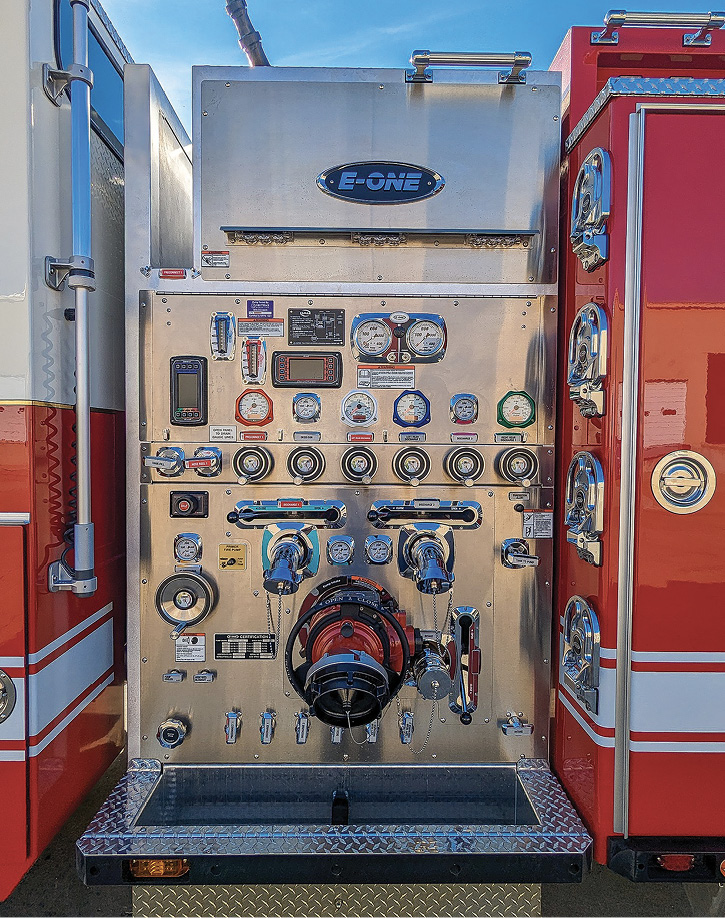
By Bob Vaccaro
The Madeira Indian Hill (OH) Fire Company was established in Madeira, Ohio, in 1924. Coverage of neighboring Indian Hill started in 1929.
Today the Madeira Indian Hill Joint Fire District, established in 1985, covers 24 square miles and a population of 15,000 residents in the City of Madeira and the Village of Indian Hill. The response district is a suburb of Cincinnati, Ohio, as well.
Chief Stephen Oughterson states that his response district is a fairly rich community with large single-family residences and gated homes with long driveways that can present a problem with apparatus placement and long hose stretches. The apparatus would have to make it down some of the long driveways in the fire company’s response district to operate efficiently at a fire scene. “There are no commercial properties in the Indian Hill section of our area, just some churches,” he says. “Two hundred commercial properties exist in Madeira, with a population spread of 11,000 in Madeira and 4,000 in Indian Hill.”
The fire company started the design and spec writing process in 2020, wanting an apparatus with a short wheelbase, a larger water tank, and the ability to carry more hose than the fire company carried on previous apparatus. “Our department generally operates with a 15-year replacement program for engines with five years in reserve,” says Oughterson. “Luckily for our department, we were able to get a quick turnaround time with delivery.”
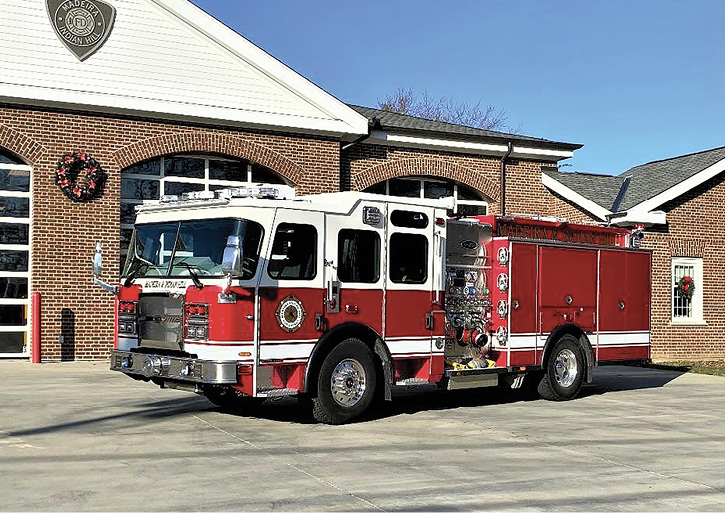
1 The Madeira Indian Hill Joint Fire District E-ONE 1,500/750 Cyclone pumper. (Photos 1-2 courtesy of the Madeira Indian Hill Joint Fire District.)
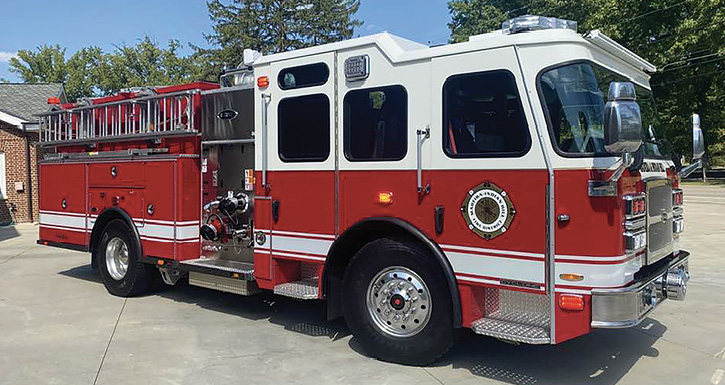
2 The officer’s side of the new pumper showing the electric ladder rack.
Madeira Indian Hill Pumper Specs
|
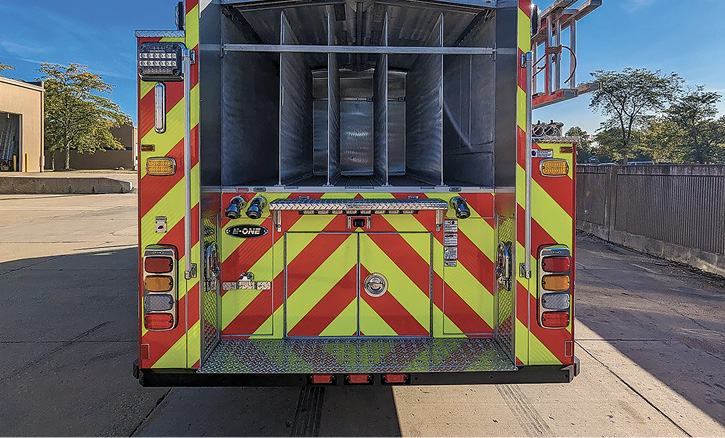
3 The rear low hosebed on the new E-ONE pumper. (Photos 3-5 courtesy of Vogelpohl Fire Equipment.)

4 The apparatus purchasing committee designed the pumper with a simple pump panel.
Oughterson explains, “Our apparatus design committee was formed with members of all three shifts. We wanted everyone to have a say in the design of this new piece of apparatus since they would all be operating the apparatus at one time or another. The vehicle also had to be able to operate out of both stations size-wise as well.”
The committee looked at three fire apparatus manufacturers and eventually decided on E-ONE, which met all of the specs, and local dealer Vogelpohl Fire Equipment, which has a great reputation in the area and mobile service, which was a deciding factor as well. “We went through Sourcewell, which made things a lot easier for our department during the ordering process and eventual decision-making process before our committee chose the manufacturer,” says Oughterson. “E-ONE was great to deal with during the whole process. Their engineers and salespeople helped us out a great deal. Oughterson adds that there were virtually no problems during the build.
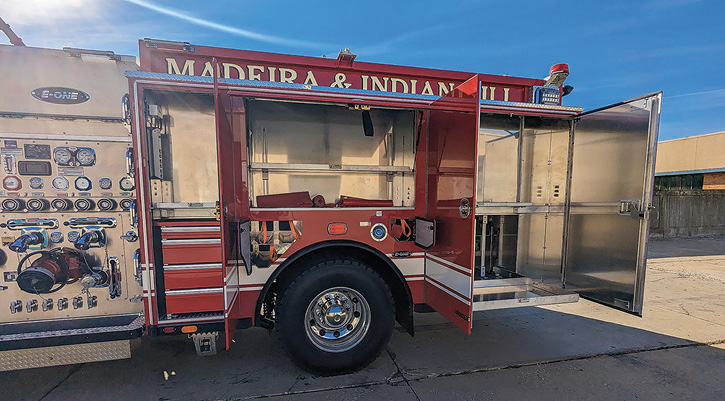
5 Large compartments allow storage of current equipment as well as room for future equipment purchases.
The engine is designed with a low hosebed to make it more ergonomic for the department’s firefighters when stretching hoselines. The rig carries 1,000 feet of 5-inch large-diameter hose; two crosslays with 200 feet of 1¾-inch hose; and 200 feet of 1¾-inch attack line, 400 feet of 2-inch attack line, 400 feet of 2½-inch line, and 600 feet of 3-inch line from the rear. There is also a reel with 100 feet of 1-inch booster line.
“Since we have a few dead-end mains in our area, we went with a 750-gallon tank,” says Oughterson. “On the officer’s side, we went with an electric ladder rack to bring the ladder lower for ease of operation. The engine carries normal engine company tools and fittings with a slide-out toolbox, forcible entry tools, battery-powered fans, two adjustable light masts, saws, and advanced life support (ALS) equipment with drug boxes and will eventually carry a full complement of battery-powered extrication tools.
Madeira Indian Hill Fire Company
|
The fire company didn’t spec a generator because the 12-V electrical system on the vehicle was more than adequate to handle the electrical load. Additionally, the pumper has large compartments that provide space for current equipment but room for future equipment additions as well.
The Madeira Indian Hill Joint Fire District had certain needs to meet with this apparatus purchase. Its fire district has various types of parameters that compelled the apparatus purchasing committee design a pumper with a short wheelbase, larger water tank for dead-end water mains, and the ability to carry more hose than normal for their set back, larger homes and long driveways.
Excellent preplanning on the part of the Madeira Indian Hill fire apparatus committee gave it a highly functional piece of fire apparatus that met all of the concerns for its response district now and well into the future.
BOB VACCARO has more than 40 years of fire service experience. He is a former chief of the Deer Park (NY) Fire Department. Vaccaro has also worked for the Insurance Services Office, the New York Fire Patrol, and several major commercial insurance companies as a senior loss-control consultant. He is a life member of the IAFC.

